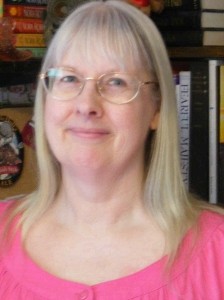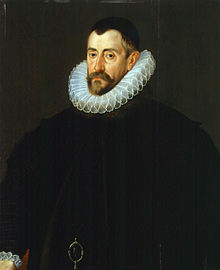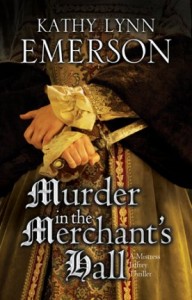 Relevant History welcomes Kathy Lynn Emerson, aka Kaitlyn Dunnett, author of over fifty books. She won the Agatha Award in 2008 for best mystery nonfiction for How to Write Killer Historical Mysteries and was an Agatha Award finalist in 2014 in the best mystery short story category for “The Blessing Witch.” Currently she writes the contemporary Liss MacCrimmon Mysteries (The Scottie Barked at Midnight) as Kaitlyn and the historical Mistress Jaffrey Mysteries as Kathy (Murder in the Merchant’s Hall). The latter series is a spin-off from her earlier “Face Down” series and is set in Elizabethan England. To learn more about her and her books, visit her web site and group blog, and follow her on Facebook.
Relevant History welcomes Kathy Lynn Emerson, aka Kaitlyn Dunnett, author of over fifty books. She won the Agatha Award in 2008 for best mystery nonfiction for How to Write Killer Historical Mysteries and was an Agatha Award finalist in 2014 in the best mystery short story category for “The Blessing Witch.” Currently she writes the contemporary Liss MacCrimmon Mysteries (The Scottie Barked at Midnight) as Kaitlyn and the historical Mistress Jaffrey Mysteries as Kathy (Murder in the Merchant’s Hall). The latter series is a spin-off from her earlier “Face Down” series and is set in Elizabethan England. To learn more about her and her books, visit her web site and group blog, and follow her on Facebook.
*****
It always amazes me that television shows and movies claim they have to change historical facts for the sake of the story. What really happened, especially in sixteenth-century England, has all the action, adventure, sex, violence, and intrigue anyone could ask for.
In my Mistress Jaffrey Mysteries, and in the earlier Face Down mystery series, as well as in the non-mystery historical novels I wrote as Kate Emerson, I set my fictional stories against a backdrop that is as real as I can make it. I’ve been reading and writing about Tudor England for over forty years and maintain the online “A Who’s Who of Tudor Women,” containing over 2000 mini-biographies, to share some of my research. When writing fiction, the technique I use most frequently is to start with a little known bit of history, find out everything I can about it, and then extrapolate from the facts to create my plot. It might not have happened that way…but it could have.
Sir Francis Walsingham, spymaster
 Sir Francis Walsingham, Queen Elizabeth’s principal secretary and spymaster and a secondary character in Murder in the Merchant’s Hall and the first book in the series, Murder in the Queen’s Wardrobe, appears in fictionalized form in a great many novels, so the challenge for me is to make my portrayal of him accurate but also distinct from what others have done. Here’s the tidbit I found to extrapolate from in Murder in the Merchant’s Hall: in August 1583, the queen sent Walsingham to Scotland on a diplomatic mission, and while he was there he fell ill. His poor health continued after his return to England in mid-October. It struck me that this might affect his ability to supervise his vast spy network and therefore offer one of his underlings an opportunity to advance his own agenda. From there it wasn’t much of a leap to imagine that this man’s plans could go awry and cause all kinds of difficulties for my fictional amateur detective, Rosamond Jaffrey.
Sir Francis Walsingham, Queen Elizabeth’s principal secretary and spymaster and a secondary character in Murder in the Merchant’s Hall and the first book in the series, Murder in the Queen’s Wardrobe, appears in fictionalized form in a great many novels, so the challenge for me is to make my portrayal of him accurate but also distinct from what others have done. Here’s the tidbit I found to extrapolate from in Murder in the Merchant’s Hall: in August 1583, the queen sent Walsingham to Scotland on a diplomatic mission, and while he was there he fell ill. His poor health continued after his return to England in mid-October. It struck me that this might affect his ability to supervise his vast spy network and therefore offer one of his underlings an opportunity to advance his own agenda. From there it wasn’t much of a leap to imagine that this man’s plans could go awry and cause all kinds of difficulties for my fictional amateur detective, Rosamond Jaffrey.
The underling in question was right there waiting for me. His name was Walter Williams, called “Watt” by his boss. In December 1582, Walsingham put him in charge of the house in Seething Lane that served as headquarters for his intelligence gatherers. Some historians dismiss Williams as incompetent, but the truth is that not much is known about him. Prior to 1583 he delivered letters between England and the Continent, conducted surveillance, and went undercover in various prisons as an agent provocateur. In June 1583, he acted as the contact for a spy working undercover in the French embassy.
Plot and subplot
Since the books in the Mistress Jaffrey series are murder mysteries, a fictional murder is at the heart of the plot, but the subplot comes straight from history. In addition to material from other sources, I found a treasure trove of factual detail in Giordano Bruno and the Embassy Affair (1991) and Under the Molehill: An Elizabethan Spy Story (2001), both written by John Bossy. The second book adds information he discovered after the publication of the first. To blend plot and subplot, I have my sleuth, Mistress Rosamond Jaffrey, visit the French embassy as part of an attempt to clear a friend of the charge of murder. There she has a chance encounter with a fellow named Throckmorton, an Englishman who has been translating coded letters from Mary, Queen of Scots for the French ambassador. This propels Rosamond into the middle of the spy story. Walter Williams’s attempts to first warn her off and then use her for his own purposes create twists and turns in both plot and subplot.
In real life, Throckmorton was arrested, and both the French and Spanish ambassadors were implicated in a conspiracy to invade England, overthrow Elizabeth, and put Mary on the throne in her place. Could an English gentlewoman visiting the French embassy have overheard a vital clue and reported it to the authorities? Since we will never know all the details that led up to Throckmorton’s arrest, I see no reason why it couldn’t have happened that way.
*****
 A big thanks to Kathy Emerson. She’ll give away an autographed hardback copy of Murder in the Merchant’s Hall to someone who contributes a comment on my blog this week. I’ll choose the winner from among those who comment by Friday at 6 p.m. ET. Delivery is available is the U.S. only.
A big thanks to Kathy Emerson. She’ll give away an autographed hardback copy of Murder in the Merchant’s Hall to someone who contributes a comment on my blog this week. I’ll choose the winner from among those who comment by Friday at 6 p.m. ET. Delivery is available is the U.S. only.
**********
Did you like what you read? Learn about downloads, discounts, and special offers from Relevant History authors and Suzanne Adair. Subscribe to Suzanne’s free newsletter.

Kathy, Thank you for insights on how to use history as a springboard for a fictional plot.
You’re welcome.
It sounds a little like looking for a needle in a haystack, but finding those details that can be worked with must be rewarding in itself. Thanks so much for the insights! (Don’t include me on the book giveaway since I’m out of the US).
I look on it as a treasure hunt😌
I enjoyed and learned from your explanation of plots and subplots and weaving history and fiction together in a plausible story. I’m very glad to have “met” you tonight, Kathy, and I intend to read one of your books in the near future. Thanks for this post.
Nice to meet you, too, Janice. Happy reading.
I love reading authors who stick to fact and write around them for a story. I don’t care for Hollywood’s tendency to change facts to promote a particular star or for some other stupid reason. “The Scarlet Letter” was the worst offender, but there are many. One of the reasons I love Suzanne Adair’s books is she can make me feel as if I am a part of the story and still stick to facts. I’m very glad to have found you, Kathy, and I intend to read you now.
Thanks, Caroline. I look on sticking as close to history as possible as a challenge.
Fascinating! First of all, anything Elizabethan-era always grabs my history-geek eye. But Walsingham has always been a particular favorite of mine–he and Doctor John Dee. So many books in my to-be-read pile, so little time…..
I’ve used Dee a bit, too, in my Face Down series. He had a finger in a lot of pies. Fascinating man.
I always enjoyed the Face Down series and I know I would enjoy this series. Thanks for a chance to win a copy.
You’re welcome, and you’ll be pleased to know that Lady Appleton does appear in this one.
Enjoyed the Blog and learning of Kathy Emerson and her writings. Historical fiction has always been my favorite reading material and the more accurate the better I liked it. Murder mysteries never interested me, but Suzanne’s books changed that for me. I enjoyed Ms. Emerson’s explanation of weaving a mystery into historical facts and thank you both for sharing your talents and knowledge with us.
Glad you enjoyed the post. The books I wrote as Kate Emerson, incidentally, are not mysteries. They are fictionalized biographies of little-known Tudor women.
I am always looking for new authors to read. This book sounds really good and the kind I enjoy.
Thanks, Joye.
I love historical fiction esp. with mysteries. Would love a chance to win this.
Thanks, Jody.
I’ve always loved history, and that make historical fiction even more fascinating to me. It’s like bringing the past to life with “real” people. Thanks for the tips on how you do your research.
You’re welcome. Marilyn.
Very interesting interview. I too enjoy looking in the nooks and crannies of history to find that one intriguing detail such as Walsingham’s illness. I look forward to reading this series!
Thank you.
I believe I became hooked on HM by DD’s Lymond series, and know Kathy was too. Since I am just a reader and not an author, I read a book, then go dig deeper into the history. (I cannot think of a better way to teach history.) Since the blog today is about my favorite era I especially liked learning a bit more about this interesting character. I see I have some more historical research I have to do. Thanks!
You’re welcome. Have fun in the 16 th century.
Kathy, one thing you and Suzanne have in common: masters at historical details and finding a great plot out of what really happened! Thats why your books are so successful. Thanks for this inside look into your process~
You’re welcome, and thanks for the kind words.
I loved the Face Down series (and am kind of hoping for more). And one of the things I loved about the series was that it does bring the period to life and doesn’t mess with the historical fact to do it. Have to try the Rosamund Jaffrey series now.
The new series picks up a few years after the Face Down books ended and most of the Face Down regulars are still around, but Rosamond has become estranged from them. The plan is to have one or two reappear in each new mystery, but it isn’t necessary to have read Lady Appleton’s earlier adventures. I keep references to past mysteries at a minimum.
Kathy, as always I love your books, and hearing a little bit of the background makes them even more interesting. I love that you use real historical events and people, and only fill in the blanks, as it were.
Thanks, Jane. That’s a good way of putting it.
I loved hearing how you work the fiction into facts. I’ll definitely be looking to emulate your suggestions. Like many of the others, I love a good historical mystery and my first coming out this year. I’ll definitely check out your titles. Thank you so much for sharing.
All best wishes for your debut. I’ll keep an eye out for your name.
” … then extrapolate from the facts to create my plot. It might not have happened that way … but it could have”
Kathy, you’ve sussed me out! I don’t ALWAYS write historical fiction, but I quite often DO use the same ‘extrapolation’ technique you describe! Thanks for an interesting blog post!